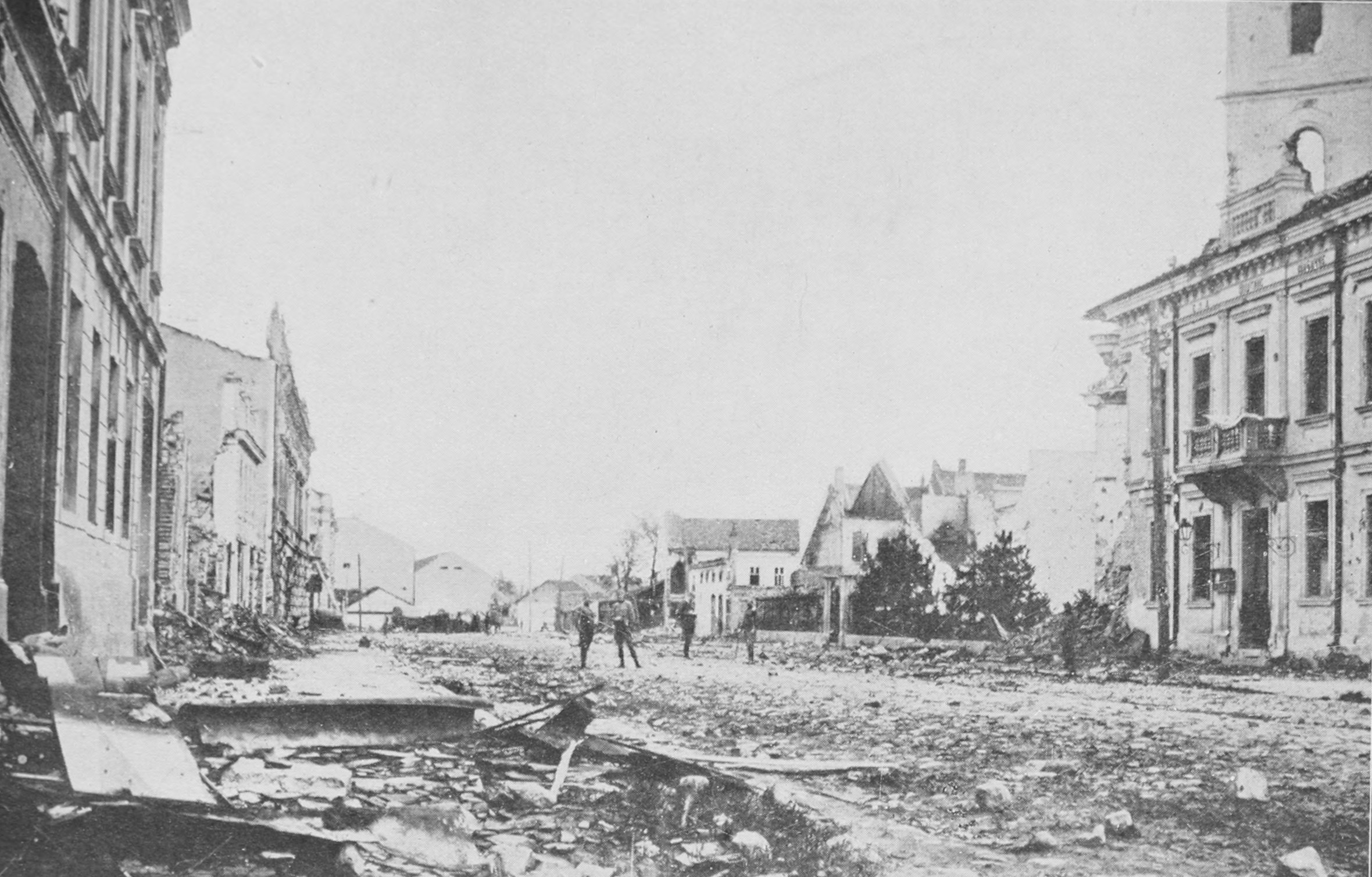|
Battle Of Drina
The Battle of the Drina ( Serbian: , ) was fought between Serbian and Austro-Hungarian armies in September 1914, near Loznica, Serbia, during the First Serbian campaign of World War I. After a first failed invasion of Serbia where he lost 40,000 men, Oskar Potiorek, the Austro-Hungarian commander of the Balkanstreitkräfte, launched a new offensive across the River Drina at the western Serbian border; after successfully crossing the river the night of 7—8 September the Austro-Hungarian forces were stopped facing strong Serbian defensive positions. In the meantime, the Serbian army was forced to end their offensive into Austrian Syrmia and regroup their forces to face the threat. Meanwhile, in the far west, a smaller force of Serbian and Montenegrin troops moved into Bosnia, taking Višegrad. In the South, the Austrians took Shabatz (Šabac). On 17 September, a counterattack pushed the Austrians back to the Drina, where both sides settled into trench warfare. The Battle ... [...More Info...] [...Related Items...] OR: [Wikipedia] [Google] [Baidu] |
Serbian Campaign (1914)
The Serbian campaign of 1914 was a significant military operation during World War I. It marked the first major confrontation between the Central Powers, primarily Austria-Hungary, and the Allies of World War I, Allied Powers, led by the Kingdom of Serbia. The campaign started on 28 July 1914, when July Crisis#Austria-Hungary declares war on Serbia (28 July), Austria-Hungary declared war on Serbia and Bombardment of Belgrade (1914), bombarded Belgrade. On 12 August, the Austro-Hungarian Army, Austro-Hungarian forces, led by General Oskar Potiorek, launched their first offensive into Serbia. The Austro-Hungarian forces, known as Balkanstreitkräfte and consisting of the 5th Army (Austria-Hungary), 5th and 6th Army (Austria-Hungary), 6th Armies, attacked Serbia from the west and north. The Royal Serbian Army, Serbian army under the command of General Radomir Putnik using their knowledge of the rugged terrain and the strategic advantage of the rivers, defeated the 5th Army at the Bat ... [...More Info...] [...Related Items...] OR: [Wikipedia] [Google] [Baidu] |
Kingdom Of Serbia
The Kingdom of Serbia was a country located in the Balkans which was created when the ruler of the Principality of Serbia, Milan I of Serbia, Milan I, was proclaimed king in 1882. Since 1817, the Principality was ruled by the Obrenović dynasty (replaced by the Karađorđević dynasty for a short time). The Principality, under the suzerainty of the Ottoman Empire, ''de facto'' achieved full independence when the very last Ottoman troops left Belgrade in 1867. The Treaty of Berlin (1878), Congress of Berlin in 1878 recognized the formal independence of the Principality of Serbia, and in its composition Nišava District, Nišava, Pirot District, Pirot, Toplica District, Toplica and Vranje districts entered the Southern and Eastern Serbia, South part of Serbia. In 1882, Serbia was elevated to the status of a kingdom, maintaining a foreign policy friendly to Austria-Hungary. Between 1912 and 1913, Serbia greatly enlarged its territory through engagement in the First Balkan War, Fi ... [...More Info...] [...Related Items...] OR: [Wikipedia] [Google] [Baidu] |
Sava
The Sava, is a river in Central Europe, Central and Southeast Europe, a right-bank and the longest tributary of the Danube. From its source in Slovenia it flows through Croatia and along its border with Bosnia and Herzegovina, and finally reaches Serbia, feeding into the Danube in its capital, Belgrade. The Sava is long, including the Sava Dolinka headwater rising in Zelenci, Slovenia. It is the largest List of tributaries of the Danube, tributary of the Danube by volume of water, and the second-largest after the Tisza in terms of catchment area () and length. It drains a significant portion of the Dinaric Alps region, through the major tributaries of Drina, Bosna (river), Bosna, Kupa, Una (Sava), Una, Vrbas (river), Vrbas, Lonja, Kolubara, Bosut (river), Bosut and Krka (Sava), Krka. The Sava is one of the longest rivers in Europe and among the longest tributaries of another river. The population in the Sava River basin is estimated at 8,176,000, and is shared by three capit ... [...More Info...] [...Related Items...] OR: [Wikipedia] [Google] [Baidu] |
Srem Offensive
The Srem Offensive was a limited offensive conducted by the Serbian 1st Army against the Austro-Hungarian Empire during the early months of the Serbian Campaign of World War I. Entente pressure for the offensive From early August 1914, Russia and France pressured Belgrade to invade Austria-Hungary and divert troops from the Eastern and Western fronts. Despite Serbia's unpreparedness for even a defensive war, let alone an offensive, the pressure mounted as the three powers grew more tense. The Grand Duke Nikolai Nikolaievich even wrote a letter to Crown Prince Alexander urging him to attack. Serbian troops were armed with Russian rifles, and they wanted compensation. Belgrade resisted, claiming truthfully it could not attack. Before the Battle of Cer, Serbian Prime Minister Nikola Pašić attempted to buy more time to prepare for the inevitable offensive his country would be forced into by informing the Russian Empire of his lack of pontoon bridges. He argued it would b ... [...More Info...] [...Related Items...] OR: [Wikipedia] [Google] [Baidu] |
Allies Of World War I
The Allies or the Entente (, ) was an international military coalition of countries led by the French Republic, the United Kingdom, the Russian Empire, the United States, the Kingdom of Italy, and the Empire of Japan against the Central Powers of the German Empire, Austria-Hungary, the Ottoman Empire, and the Kingdom of Bulgaria in World War I (1914–1918). By the end of the first decade of the 20th century, the major European powers were divided between the Triple Entente and the Triple Alliance. The Triple Entente was made up of the United Kingdom, France, and Russia. The Triple Alliance was originally composed of Germany, Austria–Hungary, and Italy, but Italy remained neutral in 1914. As the war progressed, each coalition added new members. Japan joined the Entente in 1914 and, despite proclaiming its neutrality at the beginning of the war, Italy also joined the Entente in 1915. The term "Allies" became more widely used than "Entente", although the United Kingdom, Fran ... [...More Info...] [...Related Items...] OR: [Wikipedia] [Google] [Baidu] |
Syrmia
Syrmia (Ekavian sh-Latn-Cyrl, Srem, Срем, separator=" / " or Ijekavian sh-Latn-Cyrl, Srijem, Сријем, label=none, separator=" / ") is a region of the southern Pannonian Plain, which lies between the Danube and Sava rivers. It is divided between Serbia and Croatia. Most of the region is flat, with the exception of the low Fruška gora mountain stretching along the Danube in its northern part. Etymology The word "Syrmia" is derived from the ancient city of Sirmium (now Sremska Mitrovica). Sirmium was a Celts, Celtic or Illyrians, Illyrian town founded in the third century BC. ''Srem'' ( sr-Cyrl, Срем) and ''Srijem'' ( sr-Cyrl, Сријем, label=none) are used to designate the region in Serbia and Croatia respectively. Other names for the region include: * Latin: ''Syrmia'' or ''Sirmium'' * Hungarian language, Hungarian: ''Szerémség'', ''Szerém'', or ''Szerémország'' * German language, German: ''Syrmien'' * Slovak language, Slovak: ''Sriem'' * Pannonian R ... [...More Info...] [...Related Items...] OR: [Wikipedia] [Google] [Baidu] |
Bosnia (region)
Bosnia ( sh-Latn-Cyrl, separator=" / ", Bosna, Босна, ) is the northern region of Bosnia and Herzegovina, encompassing roughly 81% of the country; the other region, the southern part, is Herzegovina. The two regions have formed a geopolitical entity since medieval times, and the name "Bosnia" commonly occurs in historical and geopolitical senses as generally referring to both regions (Bosnia and Herzegovina). The official use of the combined name started only in the late period of Ottoman rule. Geography Bosnia lies mainly in the Dinaric Alps, ranging to the southern borders of the Pannonian plain, with the rivers Sava and Drina marking its northern and eastern borders. The area of Bosnia comprises approximately 39,021 km2, and makes up about 80% of the territory of the present-day state of Bosnia and Herzegovina. There are no true borders between the region of Bosnia and the region of Herzegovina. Unofficially, Herzegovina is south of the mountain Ivan planina. A ... [...More Info...] [...Related Items...] OR: [Wikipedia] [Google] [Baidu] |
Battle Of Cer
The Battle of Cer was a military campaign fought between Austria-Hungary and Serbia in August 1914, starting three weeks into the Serbian Campaign of 1914, the initial military action of the First World War. It took place around Cer Mountain and several surrounding villages, as well as the town of Šabac. The battle, part of the first Austro-Hungarian invasion of Serbia, began on the night of 15 August when elements of the Serbian 1st Combined Division encountered Austro-Hungarian outposts that had been established on the slopes of Cer Mountain earlier in the invasion. The clashes that followed escalated into a battle for control over several towns and villages near the mountain, especially Šabac. On 19 August, the morale of the Austro-Hungarians collapsed and thousands of soldiers retreated into Austria-Hungary with many of them drowning in the Drina River as they fled in panic. On 24 August the Serbs re-entered Šabac, marking the end of the battle. Serbian casualties afte ... [...More Info...] [...Related Items...] OR: [Wikipedia] [Google] [Baidu] |
Šabac
Šabac ( sr-Cyrl, Шабац, ) is a List of cities in Serbia, city and the administrative centre of the Mačva District in western Serbia. The traditional centre of the fertile Mačva region, Šabac is located on the right banks of the river Sava. , the city proper has population of 51,163, while its administrative area comprises 105,432 inhabitants. Name The name ''Šabac'' was first mentioned in Republic of Dubrovnik, Ragusan documents dating to 1454. The origin of the city's name is uncertain; it is possible its name comes from the name of the city's main river, the Sava. The city is known by a variety of different names: ''Zaslon'' in medieval Serbian, ''Szabács'' in Hungarian language, Hungarian, ''Böğürdelen'' in Turkish language, Turkish, and ''Schabatz'' in German language, German. History Archaeological evidence attests to more permanent settlement in the area from the Neolithic. In the Middle Ages, a Slavs, Slavic settlement named ''Zaslon'' existed at the cur ... [...More Info...] [...Related Items...] OR: [Wikipedia] [Google] [Baidu] |
Višegrad
Višegrad ( sr-cyrl, Вишеград, ) is a town and municipality in Republika Srpska, Bosnia and Herzegovina. It rests at the confluence of the Drina and the Rzav (Drina), Rzav river. As of 2013, the municipality has a population of 10,668 inhabitants, while the town of Višegrad has a population of 5,869 inhabitants. The town includes the Ottoman Empire, Ottoman-era Mehmed Paša Sokolović Bridge, a UNESCO world heritage site which was popularized by Ivo Andrić in his novel ''The Bridge on the Drina''. A tourist site called ''Andrićgrad (Andrić Town)'', dedicated to Andrić, is located near the bridge. Etymology Višegrad is a South Slavic languages, South Slavic toponym meaning "the upper town/castle/fort". Geography Višegrad is located at the confluence of the Drina river and the Rzav (Drina), Rzav river in eastern Bosnia and Herzegovina, on the road from Goražde and Ustiprača towards Užice, Serbia, which is part of the geographical region of Podrinje. It is also ... [...More Info...] [...Related Items...] OR: [Wikipedia] [Google] [Baidu] |
Austro-Hungarian Rule In Bosnia And Herzegovina
Bosnia and Herzegovina fell under Austria-Hungary, Austro-Hungarian rule in 1878, when the Congress of Berlin approved the occupation of the Bosnia Vilayet, which officially remained part of the Ottoman Empire. Three decades later, in 1908, Austria-Hungary provoked the Bosnian Crisis by formally annexing the occupied zone, establishing the Condominium of Bosnia and Herzegovina under the joint control of Cisleithania, Austria and Transleithania, Hungary. History Occupation Following the Russo-Turkish War (1877–1878), in June and July 1878 the Congress of Berlin was organized by the Great Powers. The resulting Treaty of Berlin (1878), Treaty of Berlin caused Bosnia and Herzegovina to nominally remain under sovereignty of the Ottoman Empire, but was de facto ceded to Austria-Hungary, which also obtained the right to garrison the Sanjak of Novi Pazar. According to article 25: The provinces of Bosnia and Herzegovina shall be occupied and administered by Austria-Hungary. The g ... [...More Info...] [...Related Items...] OR: [Wikipedia] [Google] [Baidu] |
Syrmia County
Syrmia County (, , , ) was a historic administrative subdivision ('' županija'') of the Kingdom of Croatia-Slavonia. Croatia-Slavonia was an autonomous kingdom within the Lands of the Crown of Saint Stephen ( Transleithania), the Hungarian part of Austria-Hungary. The region of Syrmia is today split between Croatia and Serbia. The capital of the county was Vukovar (). Geography Syrmia County shared borders with other Croatian-Slavonian counties of Požega and Virovitica, the Austro-Hungarian land of Bosnia and Herzegovina, the Kingdom of Serbia, and the Hungarian counties of Bács-Bodrog and Torontál. The County stretched along the right (southern) bank of the river Danube and the left (northern) bank of the river Sava, down to their confluence. Its area was 6,866 km² around 1910. Background By the 13th century, two counties were formed in this region: Syrmia (in the east) and Vukovar (in the west). Syrmia County was an administrative division of the Kingdom of H ... [...More Info...] [...Related Items...] OR: [Wikipedia] [Google] [Baidu] |






